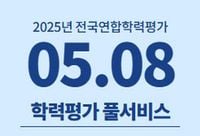On May 8, 2025, high school seniors across South Korea will participate in the nationwide May Academic Evaluation, organized by the Gyeonggi Province Office of Education. This significant event will see approximately 398,549 students from 1,855 high schools taking part in a comprehensive examination that covers five subjects: Korean, Mathematics, English, Korean History, and Inquiry (Social/Science). The exam, which runs from 8:40 AM to 4:37 PM, will employ a grading system that utilizes a complex calculation method, making it different from previous assessments.
The structure of the exam includes both common and selective subjects in the Korean and Mathematics sections. Students will choose between 'Grammar and Writing' or 'Language and Media' for Korean, and between 'Probability and Statistics', 'Calculus', or 'Geometry' for Mathematics. This approach is aimed at aligning the evaluation with the College Scholastic Ability Test (CSAT) format, which has undergone significant changes in recent years.
One of the key challenges for students is predicting grade cutoffs based on standard scores. As noted by an educational expert, “Predicting grade cutoff scores based solely on raw scores can be misleading due to the complexity of the scoring system.” This complexity arises from the way common subject scores are adjusted against selective subject scores, which can lead to variations in the final standardized scores based on the combination of subjects chosen.
Reflecting on the previous year’s academic evaluation, the cutoff scores were notably different. For instance, the 2025 May Academic Evaluation had a first-grade cutoff of 129 for Korean and 141 for Mathematics. In contrast, for the actual CSAT in 2025, the first-grade cutoff was set at 131 for both subjects. This discrepancy illustrates the variability that can occur between mock examinations and the actual test results.
Furthermore, the differences in grade cutoffs between the May Academic Evaluation and the CSAT can vary significantly. Some students may find that their scores differ by as little as 1-2 points, while others could see variations of 8 points or more. This variability highlights the importance of using the May Academic Evaluation as a tool for self-assessment rather than a definitive measure of performance.
In preparation for this year's assessment, the Educational Broadcasting System of Korea (EBS) has announced the launch of a "May Academic Evaluation Full Service." This service is designed to support students immediately after the examination by providing access to question papers and answer sheets, as well as analysis and explanation lectures regarding the exam trends. The service will be available through the EBSi Nurijip website and mobile app.
The EBS service will allow students to download question papers and answer sheets right after the exam, helping them analyze their performance. Additionally, the top 15 incorrect answer rates will be released at 6:30 PM on the same day, followed by real-time grade cutoffs at 7:30 PM. This timely feedback is aimed at enabling students to engage in practical study right after the exam.
On May 9, EBS will also release a video titled "How to Study for the June Mock Evaluation," featuring strategies from SAT special lecturers. This video aims to guide students on effective study methods based on their performance in the March academic evaluation. Starting May 12, an online mock exam will be offered for free, consisting of questions from the "2026 FINAL Realistic Mock Exam," designed to mirror the difficulty and structure of the actual CSAT.
As students gear up for the May Academic Evaluation, it is crucial they approach the results with a balanced perspective. While it is tempting to become overly anxious about performance, experts advise against viewing the outcome of the May exam as the sole indicator of future success. The differences in exam formats and participant demographics—particularly the absence of repeat students in this evaluation—mean that outcomes can vary widely.
Ultimately, the May Academic Evaluation serves as a critical stepping stone for students as they prepare for the CSAT. It offers a chance for students to assess their current academic standing and identify areas needing improvement. As the education landscape evolves, students must adapt their strategies accordingly, ensuring they are well-prepared for the challenges ahead.
In conclusion, the upcoming May Academic Evaluation is more than just a test; it’s an opportunity for students to gauge their readiness for the CSAT and to refine their study strategies. With resources like EBS's full service at their disposal, students can maximize their performance and approach the exam with confidence.
![[2026 5월학평] 지난 2년간 등급컷 어떻게 나왔나.. 지난해 표점 1등급컷 국129, 수141](https://thumbor.evrimagaci.org/I9_nJUP6pd7LkZSoLTAY5MLPyGY=/200x0/tpg%2Fsources%2F13b46a28-18dd-439c-a477-ce7b1a89faf9.jpeg)




